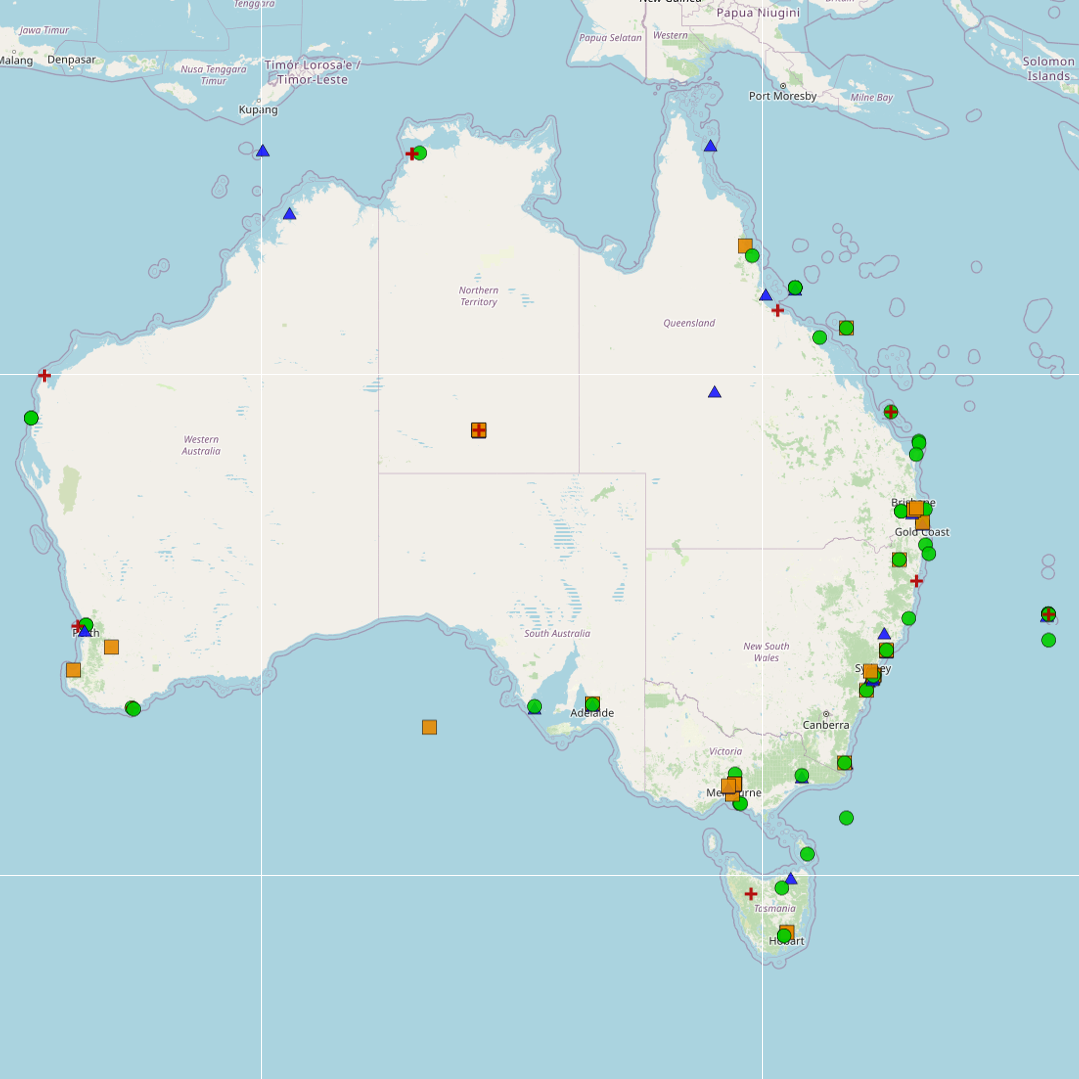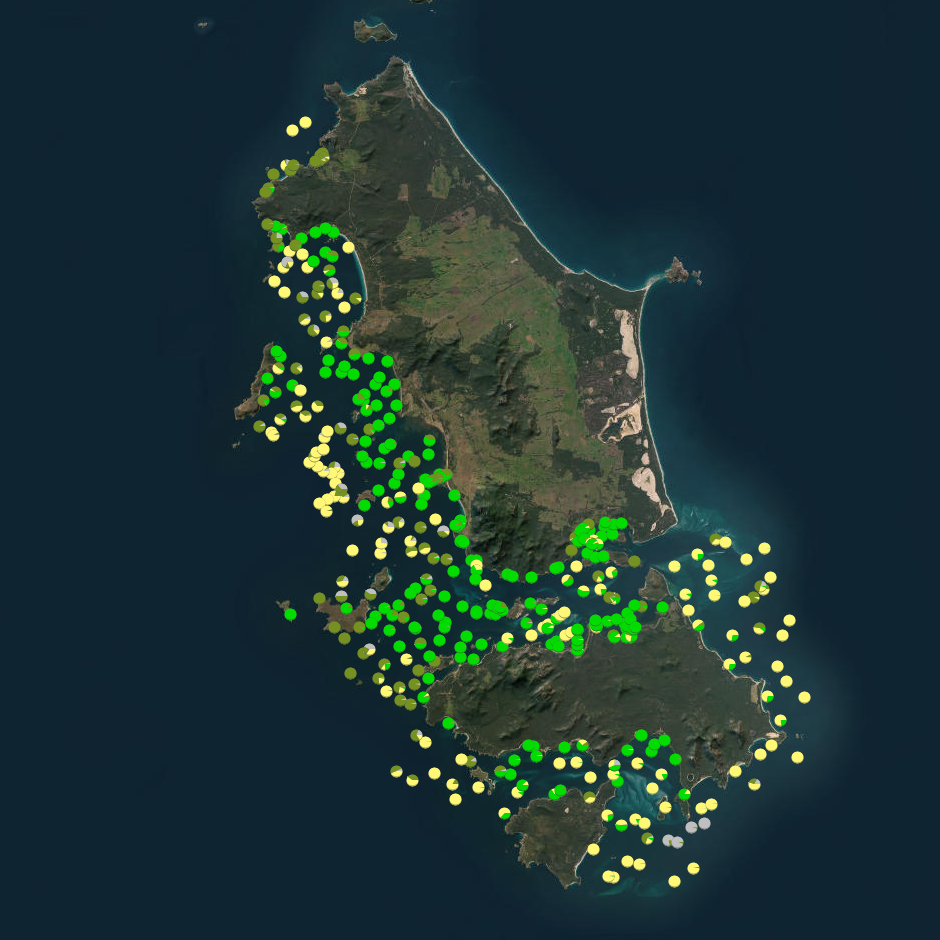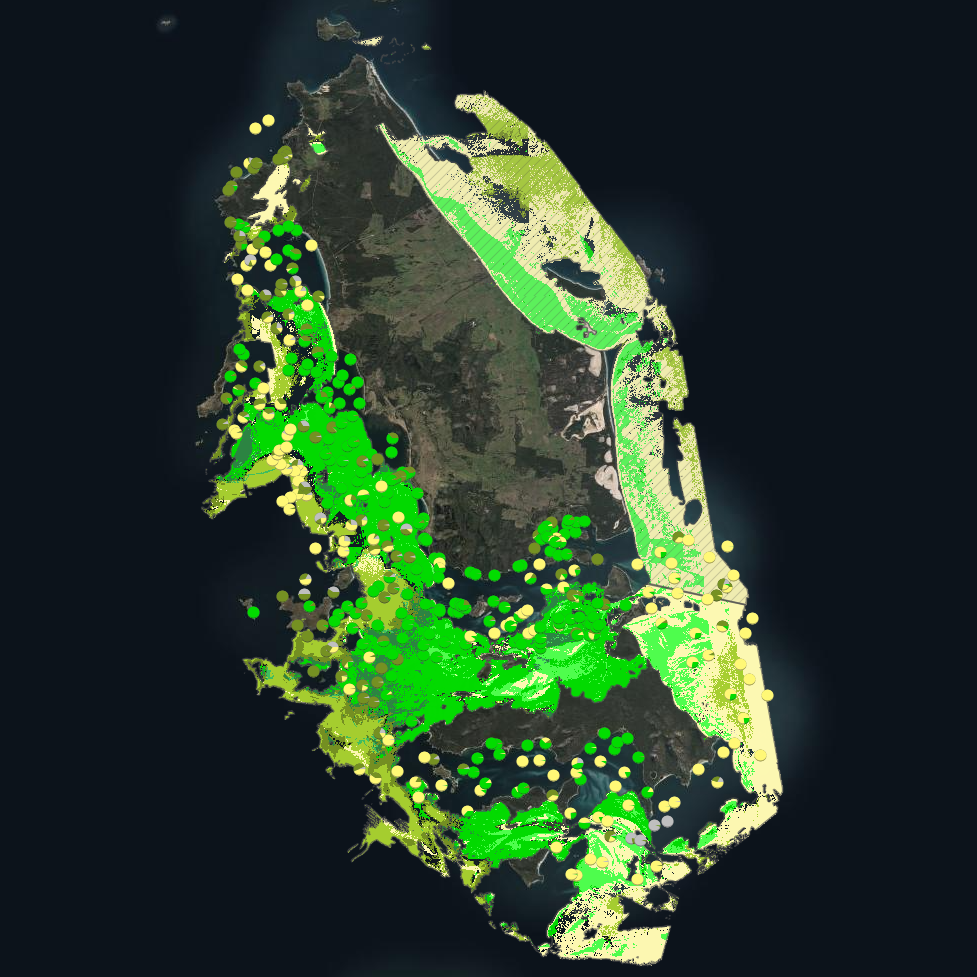National Environmental Science Program (NESP) Marine and Coastal Hub
Type of resources
Topics
Keywords
Contact for the resource
Provided by
Years
-

This metadata record provides a brief overview of the National Environmental Science Program (NESP) Marine and Coastal (MaC) Hub. The record acts as an aggregation point for all NESP Marine and Coastal Hub data collections and projects developed as part of this research program. The National Environmental Science Program (NESP) is a long-term commitment by the Australian Government to environment and climate research. The first phase invested $145 million (2014-15 to 2020-21) into 6 research hubs. The second phase invests $149 million (2020-21 to 2026-27) into 4 new research hubs. The program builds on its predecessors – the National Environmental Research Program (NERP) and the Australian Climate Change Science Programme (ACCSP) – to support decision-makers to understand, manage and conserve Australia’s environment by funding world-class biodiversity and climate science. The Marine and Coastal Hub is a collaborative partnership supported by funding from the Australian Government administered by the Department of Agriculture, Water and the Environment. The current NESP funding program runs from 2021 to 2027. The Marine and Coastal Hub is co-administered by the University of Tasmania (UTAS), and the Reef and Rainforest Research Centre (RRRC). The Marine and Coastal Hub will deliver: • applied research to support management of Australia’s marine and coastal environments including estuaries, coast, reefs, shelf and deep-water • targeted biodiversity and taxonomy products to support efficient system monitoring • environmental monitoring systems and decision-support tools. The hub will also drive coordinated research across all 4 new hubs under NESP’s ‘protected place management’ cross-cutting mission. This research will support management of Australia’s protected places and heritage, including the national park estate and Ramsar sites in both marine and terrestrial environments. Research products from the NESP Marine and Coastal Hub are available from https://nespmarinecoastal.edu.au and the Australian Ocean Data Network catalogue (http://catalogue.aodn.org.au)
-

A review of peer-reviewed publications was undertaken, focusing on coastal and marine microplastics relevant to South Eastern Australia (South Australia, Victoria, and New South Wales), as well as from ongoing citizen science programmes from AUSMAP (https://www.ausmap.org/). This dataset summarises basic information about the microplastics studies: the location of the study; if the study focused on water, sediment or biota; the type of biota (for biotic studies); and the DOI of the publication. Although the primary focus of this study was restricted to southeastern Australia, studies collated from other regions have also been included in this dataset. The outcomes of the literature review for other regions (QLD, NT, SA, WA, Tas) should not be considered comprehensive.
-

This record provides an overview of the NESP Marine and Coastal Hub scoping study - "Research needs for assessment and monitoring of nutrients, chemicals and antimicrobials in the marine environment". No data outputs were generated by this project. -------------------- Coastal water quality is threatened by an increasing volume of chemicals produced and used in our modern lives. These chemicals are commonly incorporated into pharmaceuticals and household items, and subsequently discharged into coastal areas from a broad range of point sources. Recently emerging contaminants include a variety of chemical (e.g. heavy metals, pharmaceuticals, pesticides, nutrients) and microbiological (e.g. pathogens, antibiotic resistant microbes) sources that are discharged in sewage, stormwater, estuarine flows and industrial wastes. For many of these chemicals, our understanding of their environmental concentrations and biological effects is limited. When new scientific information emerges to suggest that a particular contaminant may be hazardous, this is refered to as a contaminant of emerging concern (CEC). There is limited data about the environmental occurrence and biological effects of CECs, but emerging research suggests they have the capacity to be toxic. With an increasing list of CECs detected in the environment, important questions remain unanswered around which contaminants and scientific knowledge gaps should be prioritised. This desktop study engaged CEC stakeholders from academic research, government, water utilities, and non-government organisations to collaboratively identify priority CEC issues in Australia’s marine ecosystems. The project delivers a risk-based framework for future CEC research directions and water quality management priorities. Outputs • Final Project Report [written]
-

This record provides an overview of the NESP Marine and Coastal Hub Research Plan 2023 project "Assessing changes in black rockcod abundance and size". For specific data outputs from this project, please see child records associated with this metadata. -------------------- The Black Rockcod (Epinephelus daemelii) is a large, reef-dwelling species that can live for more than 60 years. In Australia it occurs along the coast of New South Wales, including at Lord Howe Island. Black Rockcod populations have been significantly reduced here due to overfishing, accidental hooking, and loss or degradation of estuarine and intertidal nursery habitats. As a result, the species is listed as Vulnerable under Commonwealth and NSW legislation. Despite having been protected from fishing in NSW since 1983, Black Rockcod are still taken illegally, or caught incidentally and released, which can lead to mortality post-release from embolism. Long-term population monitoring is a high priority identified by the species’ recovery plan and the NSW Fisheries Scientific Committee. In 2010, a broadscale baseline survey (81 sites) was undertaken in northern NSW and Lord Howe Island, followed by smaller surveys every four to five years. This project repeated the initial 81 baseline site surveys to assess if protection measures, such as marine protected area sanctuary zones, are assisting in recovery of black rockcod. This contributed to a 13-year time series (2010 – 2023) that was used to examine distribution and population structure of rockcod to assess if recovery actions being implemented are effective. Outputs • underwater visual census (UVC) data for black rock cod [dataset] • Final project report [written]
-

This record provides an overview of the NESP Marine and Coastal Hub small-scale study - "Towards a consolidated and open-science framework for restoration monitoring". No data outputs were generated by this project. -------------------- Coastal habitat restoration is scaling up rapidly in Australia and covers a range of diverse ecosystems including oyster reefs, seagrass meadows, mangrove forests, kelp forests, and saltmarshes. While monitoring is commonly included in these projects, approaches are often uncoordinated, inconsistently funded, and rarely follow open science protocols. Previous NESP-funded projects have advanced understanding of the ecology and service provision of threatened ecosystems and established targets for repair based on reference conditions (e.g. Marine Biodiversity Hub project B4). They also created a national database of marine and coastal restoration projects (Australian Coastal Restoration Network: project E5) and supported the development of monitoring, evaluation, reporting and improvement (MERI) systems across various sectors. Building on this foundation, the current project synthesised monitoring approaches across multiple habitat types by drawing on the collective expertise of Australian researchers. It also explored the integration of emerging technologies—such as automation, artificial intelligence, and eDNA—to improve monitoring efficiency and cost-effectiveness. The primary output of this project is a coordinated, open-science monitoring framework that incorporates clearly defined restoration goals and a core set of universal variables. Developed through expert consultation, the framework supports consistent benchmarking across projects while accommodating habitat-specific and goal-driven metrics. The framework promotes data accessibility, standardised definitions, and the integration of new technologies to streamline the development of future restoration projects and maximise the value of restoration monitoring. Outputs • Best-practice toolkit / final project report [written]
-

This record provides an overview of the NESP Marine and Coastal Hub small-scale study - "A national framework for improving seagrass restoration". For specific data outputs from this project, please see child records associated with this metadata. -------------------- Seagrasses provide resources and ecosystem services critical to the health of coastal ecosystems and human populations. They increase water clarity, stabilise sediments and reduce coastal erosion, sequester carbon, and provide habitat and food to marine animals, including commercially important fish and invertebrates. Across Australia, the loss of >275,000 ha of seagrass meadows and associated ecosystem services—valued at AU$ 5.3 billion—has contributed to the long-term degradation of estuarine and coastal marine ecosystems. Restoration of seagrass is critical for improving the health and function of these ecosystems and sustaining coastal communities and industries that depend on them, yet restoration projects to date typically occur at small scales, driven by local priorities and with variable success. This project addressed this problem by bringing together scientists and key stakeholders to collate knowledge on seagrass ecology and restoration, and generated a framework to scaling-up restoration nationally. A national workshop with experts identified a shortlist of drivers key to restoration success, including sediment dynamics, microbial communities, hydrodynamics, and species interactions. It highlighted the importance of incorporating seagrass genetics and life histories into site and donor material selection to improve long-term resilience. New technologies such as eDNA, automation, and AI were also assessed for their potential to improve monitoring and reduce costs, while standardised methodologies and molecular tools were recommended to track microbial indicators and site suitability. A key insight from the workshop was the central role of sediment processes in feedback loops that determine seagrass health—providing a foundation for more effective, scalable restoration strategies. On-ground case studies were conducted in Western Australia and New South Wales to test the proposed restoration framework in collaboration with Indigenous and community partners: sediment quality assessment and manipulation (Gamay Rangers, UNSW); seed and seedling capture using sediment-filled hessian tubes (Malgana Rangers, UWA); and large-scale seed collection for seed-based restoration through the 'Seeds for Snapper' initiative (OzFish and UWA). These trials demonstrated the effectiveness of community-led restoration and reinforced the potential of seed-based methods for scaling up seagrass recovery. Outputs • Effect of sediment quality and manipulation on seagrass transplant success [field data] • Locations and health of beachcast fragments of Posidonia in Botany Bay [field data] • Effect of engineering hydrodynamics (by use of hessian socks) on seagrass transplant success [field data] • Final project report [written]
-

Seagrass beds are a dominant marine ecosystem of Tayaritja (the Furneaux Group of Islands) in the north-eastern waters off Tasmania. Historical coarse mapping has indicated extensive beds of Posidonia, Amphibolis, Heterozostera, and Zostera species, potentially comprising some of the largest and deepest seagrass extents found in temperate Australian waters. However, limited data on the distribution and ecological value of these seagrass habitats represents a significant knowledge gap in understanding Australia's wetland natural assets. This project mapped the extent, ecological composition, population structure, and blue carbon value of seagrass beds around Tayaritja, in partnership with the Tasmanian Aboriginal Centre. The study area focused on the coastal waters surrounding Flinders Island in the western Furneaux Group, with mapping extending from the high tide line to the depth limit of reliable optical detection (approximately 30 m), based on analysis of field data and satellite imagery capabilities in the region. The field validation component of this study involved deployment of benthic video platforms to capture imagery of seagrass beds and associated ecosystems. A field campaign deployed a Benthic Observation Survey System (BOSS) and unBaited Remote Underwater stereo-Video system (stereo-uBRUV) at approximately 400 locations to collect photoquadrats and validate remote sensing outputs. Imagery annotation was conducted in the SQUIDLE+ platform. See dataset https://doi.org/10.25959/e4s6-ge74 for habitat maps derived from field validation and remote sensing inputs. The approach developed through this study contributed to the creation of the NESP Standard Operating Procedure (SOP) for Seagrass Mapping using Optical Remote Sensing (https://sustainabledevelopmentreform.github.io/nesp-sop-seagrass-mapping).. See the "Lineage" section of this record for full methodology of field collection techniques.
-

This record provides an overview of the NESP Marine and Coastal Hub Research Plan 2023 project 3.7 – Identifying and overcoming barriers to coastal and marine habitat restoration and Nature based Solutions in Australia. All outputs of this project are written (i.e. no data outputs). -------------------- There is an increasing need for and investment in coastal and marine restoration around Australia to help manage habitat and biodiversity loss, water quality, coastal inundation and erosion, and blue carbon assets. These projects are undertaken by a range of Commonwealth, state and local government agencies, NGOs, and community groups, and range across different habitat types and scale. However, a number of barriers currently preclude widespread uptake and implementation of habitat restoration and nature-based solutions (NbS) in Australia, which centre on: 1) policy and legislative barriers; 2) engineering adoption of NbS; and 3) Aboriginal and Torres Strait Islander inclusion and co-design. Overcoming barriers to marine and coastal restoration, and Nature-based Solutions (NbS) adoption is critical to safeguarding Australia’s marine estate. We focus this research on three thematic areas that represent roadblocks and opportunities for more inclusion in implementing and scaling-up restoration and NbS: 1. Engaging policy and permitting regulators to identify and breakdown barriers for marine and coastal habitat restoration; 2. Understanding and up-take of NbS by the engineering sector; and 3. Inclusion of Aboriginal and Torres Strait Islanders in restoration and NbS This research was conducted through in person and virtual workshops, with the outcome being advancement of effective approaches to overcome these challenges. Outputs • Identifying and overcoming barriers to marine and coastal habitat restoration and nature-based solutions in Australia [project summary - written] • A blueprint for overcoming barriers to the use of nature-based coastal protection in Australia [written] • Legislative permitting processes for restoration [written] • Pathways to Aboriginal and Torres Strait Islander inclusion and co-design in restoration [written]
-
This data is from the 2021 'Seeds for Snapper' season which is a community volunteer seed based seagrass restoration program located in Perth, Western Australia. It details the effort that went into the collection of Posidonia australis seagrass fruit including number of divers, number of shore support personnel, volunteered hours, and fruit collection metrics (volume, estimated number).
-

Seagrass beds are a dominant marine ecosystem of Tayaritja (the Furneaux Group of Islands) in the north-eastern waters off Tasmania. Historical coarse mapping has indicated extensive beds of Posidonia, Amphibolis, Heterozostera, and Zostera species, potentially comprising some of the largest and deepest seagrass extents found in temperate Australian waters. However, limited data on the distribution and ecological value of these seagrass habitats represents a significant knowledge gap in understanding Australia's wetland natural assets. This project mapped the extent, ecological composition, population structure, and blue carbon value of seagrass beds around Tayaritja, in partnership with the Tasmanian Aboriginal Centre. The study area focused on the coastal waters surrounding Flinders Island in the western Furneaux Group, with mapping extending from the high tide line to the depth limit of reliable optical detection (approximately 30 m), based on analysis of field data and satellite imagery capabilities in the region. This record specifically describes the benthic mapping component of the study. See https://doi.org/10.25959/WRXK-KV06 for imagery annotation data from the field validation campaigns. A combination of close-range remote sensing methods was used to map the extent and ecological values of seagrass beds. The approach developed through this study contributed to the creation of the NESP Standard Operating Procedure (SOP) for Seagrass Mapping using Optical Remote Sensing (https://sustainabledevelopmentreform.github.io/nesp-sop-seagrass-mapping).. High-resolution satellite imagery from Sentinel-2 (10 m) sensors, combined with bathymetric LiDAR data and oceanographic variables, was used to map baseline seagrass extent and composition. A field campaign deployed a Benthic Observation Survey System (BOSS) and unBaited Remote Underwater stereo-Video system (stereo-uBRUV) at approximately 400 locations to validate remote sensing outputs. From these data, maps were produced showing the extent and coverage of seagrass, sand, and macroalgae, and where possible, seagrass species composition, subject to water depth and clarity constraints. See the "Lineage" section of this record for full methodology. Three key types of mapping products were developed: ---Occurrence probability maps--- Continuous probability surfaces (0-100%), modelled from presence/absence data, indicating the likelihood of habitat presence at each pixel for: • Seagrass (all morphologies; > 5% cover observed in underwater field imagery) • Macroalgae species/assemblages • Sand ---Habitat percentage cover maps--- Quantitative estimates of percent cover for each habitat category: • Seagrass (all morphologies) • Macroalgae species/assemblages • Sand ---Derived products--- • Baseline binary presence/extent maps derived from optimised probability thresholds: ○ Seagrass: sgprob > 0.5 & sgprob > macroprob & sandcover < 0.9 ○ Macroalgae: macroprob > 0.5 & macroprob > sgprob & sandcover < 0.9 ○ Sand: sandprob > 0.5 & sandcover < 0.2 • Predicted seagrass species composition of binary extent map. • Fractional cover visualisation: combining cover percentages of multiple habitats into a single composite product • Composite habitat maps: combining binary habitat extents and delineating mixed habitat classes These complementary products serve different purposes: probability maps provide confidence measures, extent maps delineate habitat boundaries, percent cover maps support quantitative analysis of habitat density patterns, and composite habitat maps represent the diversity of mixed habitat classes. Together, they provide a comprehensive understanding of seagrass and associated habitat distribution across the study area.
 IMAS Metadata Catalogue
IMAS Metadata Catalogue